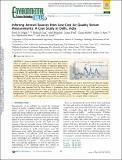| dc.contributor.author | Hagan, David Henry | |
| dc.contributor.author | Gani, Shahzad | |
| dc.contributor.author | Bhandari, Sahil | |
| dc.contributor.author | Patel, Kanan | |
| dc.contributor.author | Habib, Gazala | |
| dc.contributor.author | Apte, Joshua S. | |
| dc.contributor.author | Hildebrandt Ruiz, Lea | |
| dc.contributor.author | Kroll, Jesse | |
| dc.date.accessioned | 2019-09-23T18:49:16Z | |
| dc.date.available | 2019-09-23T18:49:16Z | |
| dc.date.issued | 2019-07 | |
| dc.date.submitted | 2019-07 | |
| dc.identifier.issn | 2328-8930 | |
| dc.identifier.uri | https://hdl.handle.net/1721.1/122279 | |
| dc.description.abstract | Low-cost sensors (LCS) offer the opportunity to measure urban air quality at a spatiotemporal scale that is finer than what is currently practical with expensive research- or regulatory-grade instruments. Recently, the LCS research community has focused largely on sensor calibration, pollution monitoring, and exposure assessment; here, we investigate the applicability of LCS for characterizing particulate pollution sources in an urban environment. Using an integrated multipollutant LCS system (which measures both gases and particles), we collected air quality data for 6 weeks during the winter at a site in Delhi, India. The results were compared to measurements taken by co-located research-grade particle instruments. Non-negative matrix factorization was used to deconvolve LCS data into unique factors that were then identified by examining the factor composition and comparing them to the research-grade measurements. The data were described well by three factors: a combustion factor characterized by high CO levels and two factors characterized by measured particles. These factors align well with measurements by research-grade instruments, including particle types determined from factor analysis of online particle composition measurements. This work demonstrates that multipollutant LCS measurements, despite their inherent limitations (e.g., calibration challenges and inability to measure smallest particles), can provide insight into sources of fine particulate matter in a complex urban environment. | en_US |
| dc.language.iso | en | |
| dc.publisher | American Chemical Society (ACS) | en_US |
| dc.relation.isversionof | http://dx.doi.org/10.1021/acs.estlett.9b00393 | en_US |
| dc.rights | Creative Commons Attribution-NonCommercial-NoDerivs License | en_US |
| dc.rights.uri | http://creativecommons.org/licenses/by-nc-nd/4.0/ | en_US |
| dc.source | ACS | en_US |
| dc.title | Inferring Aerosol Sources from Low-Cost Air Quality Sensor Measurements: A Case Study in Delhi, India | en_US |
| dc.type | Article | en_US |
| dc.identifier.citation | Hagan, David H. et al. "Inferring Aerosol Sources from Low-Cost Air Quality Sensor Measurements: A Case Study in Delhi, India." Environment Science & Technology Letters 6, 8 (July 2019): 467-472 © 2019 American Chemical Society | en_US |
| dc.contributor.department | Massachusetts Institute of Technology. Department of Civil and Environmental Engineering | en_US |
| dc.contributor.department | Massachusetts Institute of Technology. Department of Chemical Engineering | en_US |
| dc.relation.journal | Environment Science & Technology Letters | en_US |
| dc.eprint.version | Final published version | en_US |
| dc.type.uri | http://purl.org/eprint/type/JournalArticle | en_US |
| eprint.status | http://purl.org/eprint/status/PeerReviewed | en_US |
| dc.date.updated | 2019-09-20T13:43:16Z | |
| dspace.date.submission | 2019-09-20T13:43:18Z | |
| mit.journal.volume | 6 | en_US |
| mit.journal.issue | 8 | en_US |
